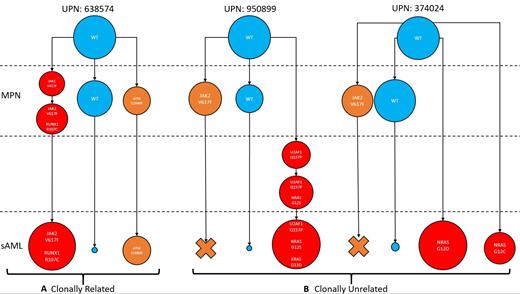The JAK2V617F variant is an acquired somatic mutation recurrently found in myeloproliferative neoplasm (MPN) patients and is used as a diagnostic marker. While considered a strong MPN driver mutation, this variant is sometimes absent in secondary acute myeloid leukemia (sAML) samples which transform from antecedent JAK2-mutant MPNs. The transformative evolution of MPN to sAML is thought to be driven by acquisition of additional genetic mutations affecting epigenetic modifiers (e.g. TET2), tumor suppressor genes (e.g. TP53), and splicing regulation, but the contribution and sequence of onset for these specific genetic events is not well understood. It is currently unknown why or how patients with a JAK2-mutant MPN may develop a JAK2 wild-type sAML. This transformation sequence is coupled with very limited treatment options and a survival of less than 6-months. Elucidating the evolutionary trajectory of secondary leukemic mutation occurrence is paramount for disease monitoring and early detection.
To understand this evolutionary trajectory, we employed single cell proteogenomic analysis for three separate paired MPN patient samples (2 MF; 1 PV) who progressed to sAML stage. Clinical sequencing data indicated presence of the JAK2 V617F mutation in all three samples at the MPN stage whereas this mutation was not detected at the sAML stage. We employed the MissionBio Tapestri platform to delineate the clonal trajectory of transformation to determine if sAML and MPN driver clones share a common founder clone or if they arise through independent, non-clonally related founders. Utilization of this single-cell platform enabled us to investigate two potential models of transformation. First, two distinct mutation phases of MPN to sAML occur wherein the JAK2 -mutant clone and sAML driver mutations originate form a shared founder clone. In this model, an MPN phenotype driven by JAK2-mutant clones arises in patients first, followed by the sAML disease stage driven by leukemic mutations. An alternative tested model is that MPN and sAML originate as separate clones wherein the JAK2 mutant hematopoietic stem cells (HSCs) give rise to an MPN phenotype first, while the independent sAML clone(s) grow slowly yet separately in the background of the existing MPN. Both models provide a plausible explanation which results in leukemic blast stage clones harboring leukemic mutations but lacking the MPN driving mutation JAK2V617F.
Single-cell analysis detected the JAK2V617F mutation in both the MPN (MF) as well as the sAML stage in one of the paired patient samples in which JAK2 was previously reported as wild-type at the sAML stage. This sample also contained a RUNX1 mutation at the sAML stage as well as a clonally unrelated ATM mutation (Figure 1A). The single-cell data for the remaining two paired patient samples (1MF; 1PV) demonstrated that pre-leukemic driver mutations were not detected within the JAK2-mutant clones at the MPN stage or during a middle time-point stage before AML diagnosis. Single-cell sequencing from the sAML time point for both samples demonstrated loss of the JAK2-mutant clone (verified by ddPCR analysis), amidst presence of leukemic driver mutant clones (Figure 1B). This clonal hierarchy suggests that the leukemic mutations were not present within the JAK2-mutant clones during the MPN stage and arose in the background of the MPN where they outcompeted the MPN driver clone during sAML transformation. Further, this hierarchy suggests that the AML driver mutations do not share a clonal intermediate ancestor with the JAK2 mutant cells which drove the MPN.
These data demonstrate that one clonal trajectory of JAK2-mutant MPN to JAK2 wild-type sAML is through independent leukemic clones arising in the background of MPN and outcompeting the JAK2-mutant clones. In these instances, it is more appropriate to view these patients as de novo AML cases arising in a background of pre-existing MPN, which could influence treatment decisions and disease surveillance.
Disclosures
Oh:CTI BioPharma, Bristol Myers Squibb, Disc Medicine, Blueprint Medicines, PharmaEssentia, Constellation/MorphoSys, Geron, AbbVie, Sierra Oncology/GSK, Cogent, Incyte, Morphic, Protagonist: Consultancy.


